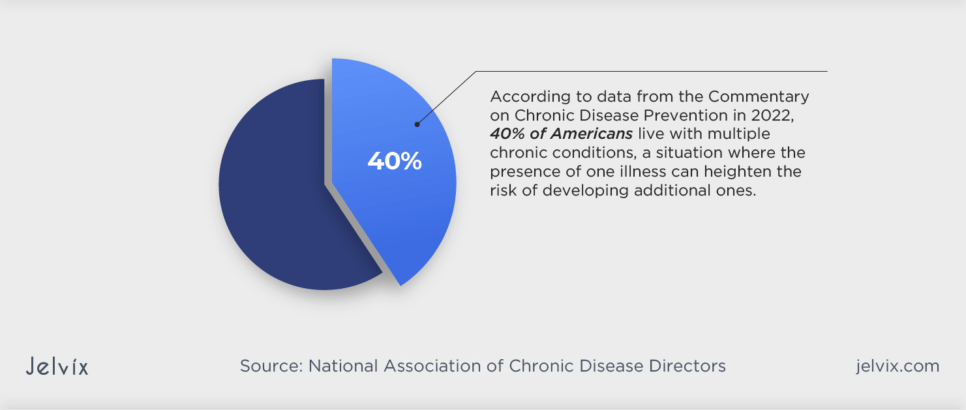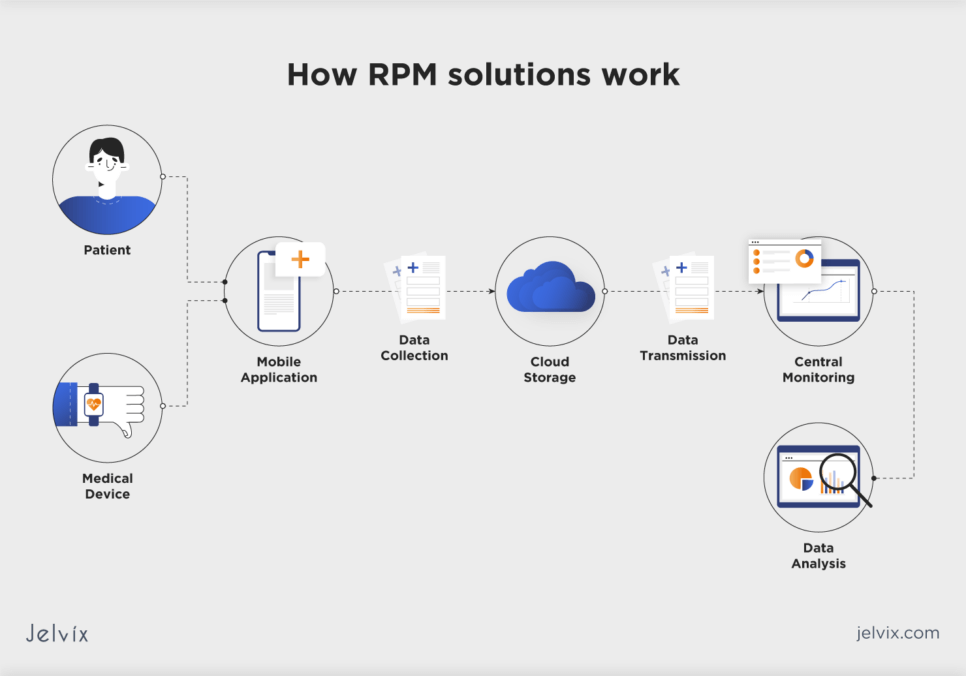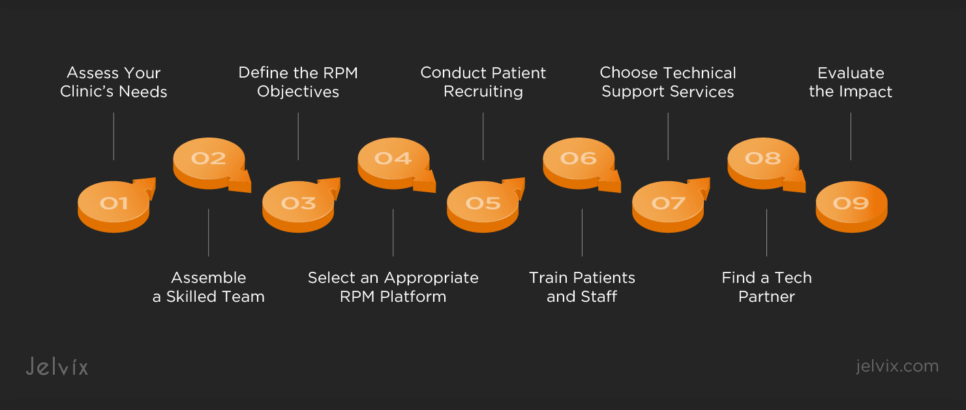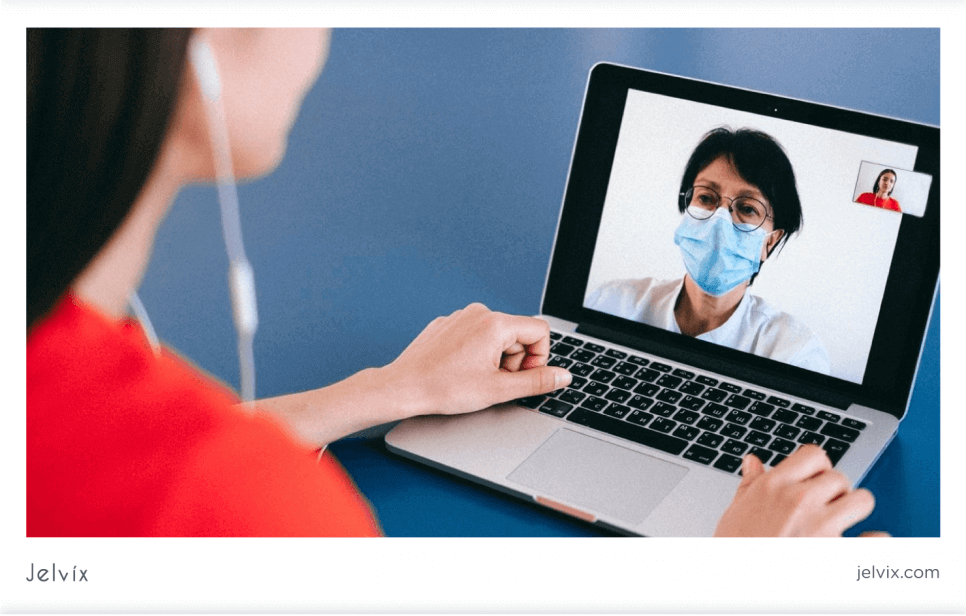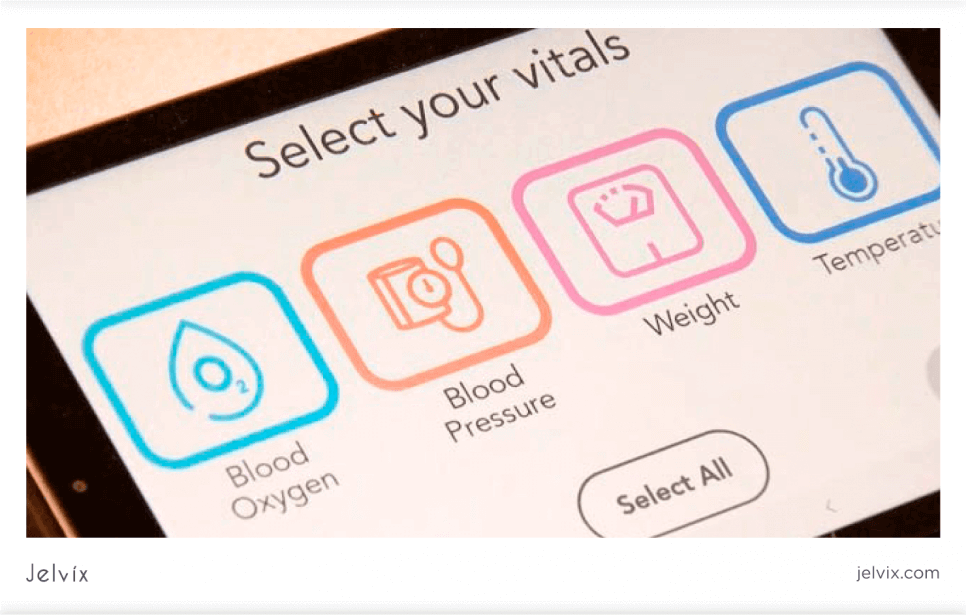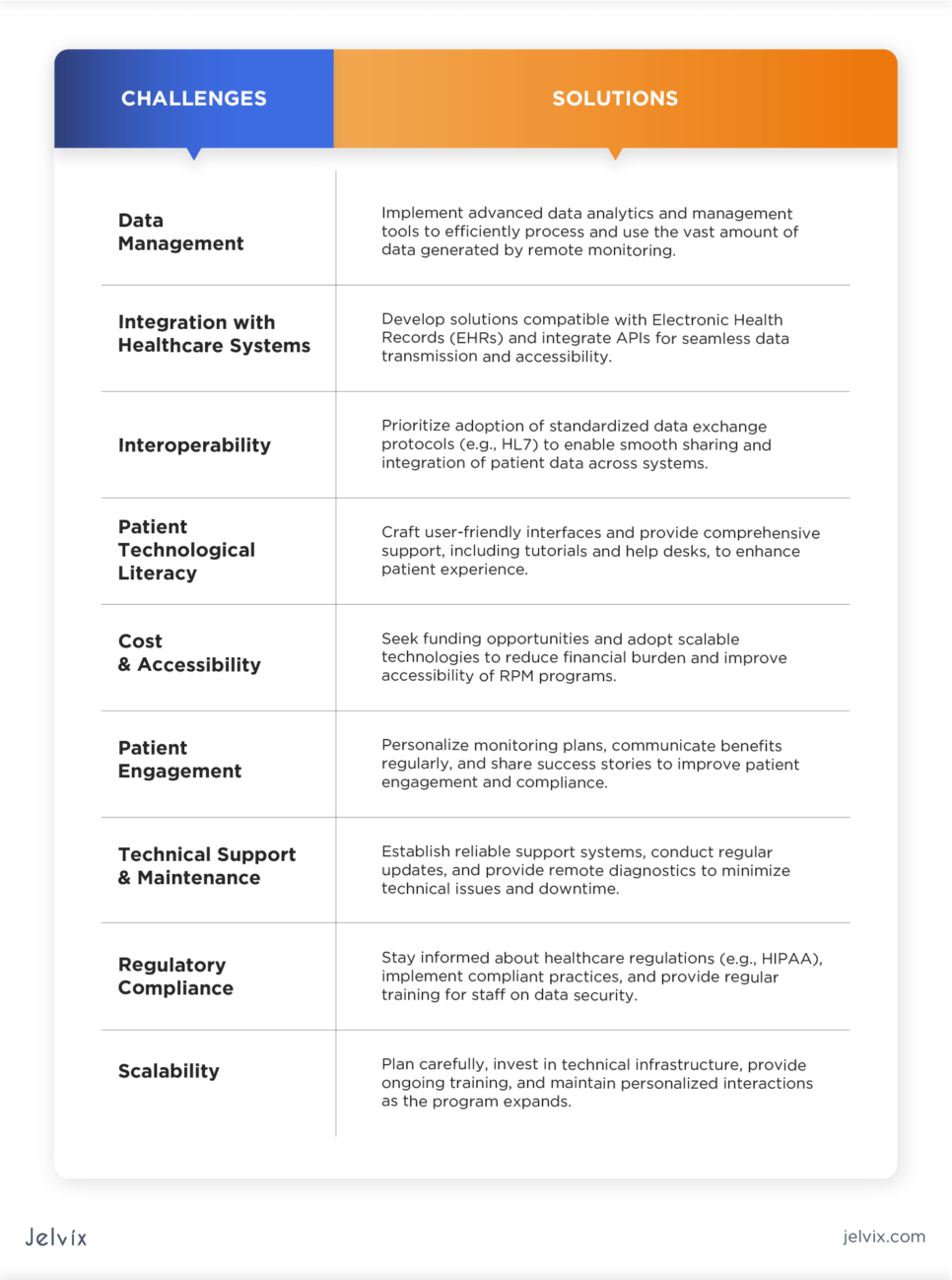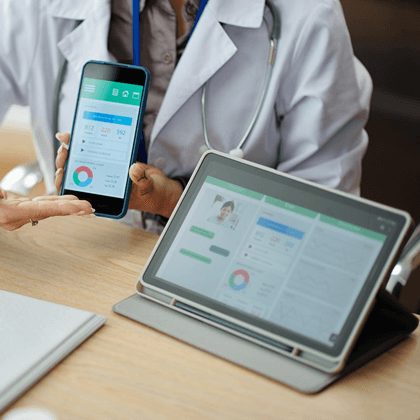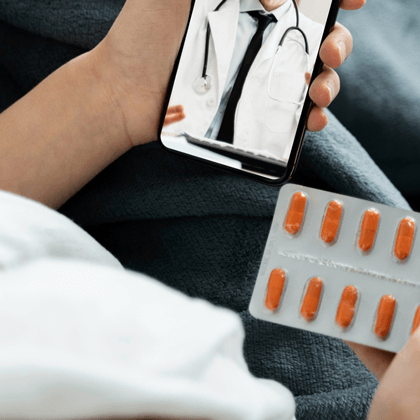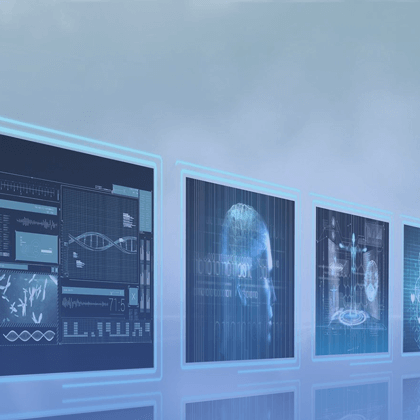Lots of people suffer from chronic conditions that require constant monitoring. NACDD reports that about 40% of Americans live with multiple chronic conditions, where one illness can increase the risk of developing additional ones.
Healthcare organizations seek to implement remote monitoring solutions to be aware of patients’ vital signs. However, RPM can be complex to develop and difficult to integrate into existing systems without a solid understanding of the technical and legal aspects. What’s more, providers often face the problem of staff and patient training putting RPM adoption under threat.
If you’re a healthcare provider aiming at enhancing patient care through remote monitoring, read this article. You’ll find out how to seamlessly implement RPM into your healthcare environment while ensuring patient engagement and maintaining data security.
What Does RPM Mean?
RPM stands for remote patient monitoring. It is a healthcare delivery method that uses technology to monitor patients’ health outside of traditional clinical settings. This approach is beneficial for managing chronic conditions, post-operative care, and preventive health measures.
RPM systems involve the use of wearables, mobile apps, and other health monitoring devices that collect health data from patients remotely. The collected info is then transmitted securely to healthcare professionals in real time. This allows physicians to monitor patients’ health statuses continuously, assess the effectiveness of treatments, and make timely decisions on care.
How RPM solutions work:
- Data collection: RPM relies on a range of medical devices and sensors to gather a wealth of health-related information such as vital signs, glucose levels, medication adherence, and symptoms;
- Data transmission: the collected patient data is securely transmitted in real-time through various communication channels, ensuring the timely delivery of health information;
- Central monitoring: healthcare professionals, including physicians, nurses, and care teams, access the real-time patient data through a centralized monitoring system that provides a comprehensive view of the patient’s health status;
- Data analysis: RPM systems often include data analysis tools and algorithms that help physicians interpret the collected information and make informed decisions on further treatment.
The Importance of Using Remote Patient Monitoring Devices
RPM delivered significant benefits to both patients and doctors during the COVID-19 pandemic. In particular, remote monitoring allowed patients to receive medical care without visiting crowded healthcare facilities, minimizing the risk of exposure to the disease. NIH reported that RPM demonstrated significant enhancements for patients who experienced social isolation, probably due to the care delays these patients used to face.
Now, RPM keeps offering numerous advantages, including improved access to healthcare, reduced healthcare delivery costs, and enhanced patient engagement. Embracing RPM technology empowers healthcare providers to offer more efficient services, leading to enhanced patient satisfaction and overall well-being.
Long-Term Cost Benefits
According to ScienceDirect research, RPM proved to be highly cost-effective in managing hypertension. It also showed the potential to be cost-effective for treating heart failure and chronic obstructive pulmonary disease (COPD).
RPM cuts healthcare costs by minimizing the need for in-person visits, reducing hospital readmissions, and allowing for the early detection and treatment of health issues before they escalate into more serious and costly conditions. By monitoring patients continuously, physicians can adjust treatments promptly, leading to the efficient use of resources and saving on the costs associated with chronic disease management.
Less Congestion in Hospitals
A study by JAMA suggests that remote monitoring could potentially lead to 87% fewer hospitalizations. That is possible because, with RPM, patients receive high-quality care from the comfort of their homes without the necessity to visit a hospital regularly. This makes care more accessible and alleviates congestion in healthcare facilities, ensuring that in-person care is available for those who need it most.
Real-Time Patient Monitoring
One of the most significant advantages of RPM is the ability to monitor patients’ health data in realtime. This immediate access to vital health information allows healthcare professionals to make informed decisions swiftly, potentially preventing health crises. Real-time monitoring also facilitates a dynamic and responsive approach to treatment, as interventions can be adjusted based on the latest data, leading to personalized and effective care.
Improved Healthcare Quality
RPM enhances healthcare quality by enabling engagement between patients and physicians. This ongoing interaction results in a deeper understanding of a patient’s health status and needs, leading to customized and effective care plans. The convenience and accessibility of RPM-based care can increase patients’ adherence to treatment plans, medication schedules, and lifestyle modifications. It results in the proactive management of their health, contributing to better outcomes and higher patient satisfaction.
9 Steps to Implement Patient Remote Monitoring Solutions
Integrating a new care model into the existing healthcare system requires a structured approach to ensure alignment with patient needs and technology integration. The Jelvix team recommends that providers follow a step-by-step approach to implement an RPM solution seamlessly.
Step 1. Assess Your Clinic’s Needs
Start by conducting a thorough assessment of your target population. This should include analyzing their demographics, healthcare challenges, and specific conditions that require remote monitoring. This initial assessment will ensure your RPM program is tailored to address your patients’ most pressing needs, delivering meaningful benefits. If your clinic serves an aging population with a high prevalence of diabetes, your RPM program should focus on remote glucose monitoring, medication adherence, and lifestyle management to enhance diabetes care and reduce complications.
Step 2. Assemble a Skilled Team
Success in RPM integration requires a multidisciplinary team whose combined expertise will enhance developing, implementing, and managing the RPM program effectively. Patient management professionals will help enhance patient engagement, and administrative staff will take care of logistics. This collaborative effort, drawing from diverse skill sets, will help provide a patient-centric and technically sound RPM program, contributing to its long-term success.
Step 3. Define the RPM Objectives
Clearly define the objectives of your RPM program. You can follow the SMART strategy, where your objectives should be specific, measurable, achievable, relevant, and timely. For example, you might aim to reduce the number of emergency department visits among your RPM patients by a certain percentage or improve the management of chronic diseases.
Step 4. Select an Appropriate RPM Platform
Choose an RPM platform that aligns with your program’s objectives and support user-friendly interfaces for patients and doctors. Ensure that the chosen platform complies with healthcare regulations, such as HIPAA, and adheres to data privacy and security standards, such as FHIR and HL7. Also, consider its compatibility with existing EHRs in hospitals to facilitate seamless data integration.
Step 5. Conduct Patient Recruiting
Identify the patients who will benefit most from your RPM program, particularly those with chronic conditions requiring regular monitoring or at high risk of specific health issues. Develop tailored recruitment strategies considering patient demographics, age, tech proficiency, and health literacy. Actively engage patients by communicating program benefits, providing education, and supporting them in device usage.
Step 6. Train Patients and Staff
Comprehensive training is essential to ensure that both patients and healthcare workers can effectively use your RPM technology. Patients should be trained on how to use monitoring devices and educated on how to respond to alerts or notifications generated by the RPM system. Train healthcare staff thoroughly to interpret RPM data accurately, identifying trends and potential health issues.
Step 7. Choose Technical Support Services
Reliable support minimizes disruptions and ensures that technical issues are addressed swiftly. Tailor the services level to match your program’s needs, whether it’s 24/7 helpdesk support, on-site assistance, or remote troubleshooting. Ensure that your chosen support services seamlessly integrate with your tech vendors for effective issue resolution.
Step 8. Find a Tech Partner
Consider collaborating with a software development partner with expertise in RPM solutions. A strong partnership with a trusted expert can enhance the technical robustness of your RPM program. A tech partner will help develop and integrate advanced features, ensure your program meets legal standards, and provide ongoing technical support.
Step 9. Evaluate the Impact
Assess the program’s cost-effectiveness by comparing the costs of RPM implementation to the savings achieved through reduced hospital admissions or other healthcare expenses. Measure patient engagement levels and the extent to which they actively participate in the RPM program. Collect patient feedback and use the insights gained from the evaluation process to guide future improvements and optimizations, ensuring that your RPM program continues to meet its goals and deliver positive outcomes.
These steps can provide a clear roadmap for healthcare providers, ensuring that everyone understands the objectives, processes, and roles within the RPM program. A structured approach benefits the implementation process and helps avoid common mistakes. In case you have any questions or concerns about the RPM development process, you’re welcome to get in touch with our managers for assistance.
Using Multiple Devices Simultaneously to Enhance RPM Services
Employing various medical devices and sensors to monitor different aspects of a patient’s health concurrently can offer comprehensive insights into health conditions and enhance the quality of care. This enables early detection of abnormalities or changes in vital signs, allowing physicians to intervene promptly.
Let's find out what telemedicine and telehealth mean, what is a difference and how to use these terms correctly.
Comprehensive Patient Care
Using multiple monitoring devices can help physicians see the full picture of a patient’s current health condition. Monitoring heart rate and oxygen levels simultaneously can help identify potential cardiac issues. A patient recovering from surgery can have their heart rate, respiratory rate, and activity levels monitored simultaneously to ensure a smooth recovery process.
Customized Care Plans
Multiple devices enable healthcare providers to tailor care plans to each patient’s unique needs. For instance, a patient with diabetes can benefit from a combination of devices for glucose monitoring, blood pressure tracking, and weight management, allowing for personalized care and adjustments to treatment plans.
Data Analytics and Predictive Insights
The integration of data from multiple devices enables advanced analytics and the identification of trends and patterns. This data-driven approach can lead to predictive insights, allowing physicians to address health issues before they escalate.
Efficient Resource Allocation
Simultaneous use of multiple devices allows healthcare pros to allocate resources efficiently. Physicians can prioritize patients based on the severity of their conditions and focus on those who require immediate attention while maintaining remote monitoring for stable patients.
Challenges of Implementing a Remote Patient Monitoring Program
Although RPM solutions bring numerous benefits when it comes to patient engagement and healthcare outcomes, their implementation involves challenges that healthcare providers should not ignore. The Jelvix team recommends that they address these issues and follow expert tips that will help enhance patient care and reduce the costs associated with integration.
Data Management
The vast amount of data generated by remote monitoring systems can overwhelm healthcare providers, making it difficult to extract meaningful insights. Implementing advanced data analytics and management tools can help efficiently process and use this information. For instance, using machine learning algorithms to identify patterns and trends in patient data can lead to early detection of health issues and informed decision-making.
Integration with Healthcare Systems
Seamless integration of remote monitoring data with existing healthcare systems is needed to improve clinical decision-making. Developing solutions that are compatible with EHRs ensures that patient information is easily accessible to physicians at any time. As an option, integrate APIs to allow remote monitoring devices to securely transmit data to electronic records and streamline the integration process as a result.
Interoperability
Various RPM devices, software, and healthcare systems may use different data standards and formats, preventing them from seamless operation. Interoperability requires aligning these standards to enable data exchange without a loss of meaning or integrity. The Jelvix team recommends that providers prioritize the adoption of standardized data exchange protocols, such as HL7, to enable the smooth sharing and integration of patient data across various systems.
Patient Techn Literacy
Navigating new technologies can be daunting for patients, especially the elderlys, potentially hindering program adoption. Crafting a user-friendly interface and offering comprehensive support, including tutorials, help desks, and step-by-step guides, can enhance user experience and make it easier for patients to use monitoring devices.
Cost and Accessibility
The initial setup and ongoing costs of remote patient monitoring programs can be substantial. Seeking funding opportunities and adopting scalable technologies can make these programs more accessible to healthcare providers of all sizes. Collaborating with tech companies that offer cost-effective monitoring devices can help reduce the financial and regulatory burden.
Patient Engagement
Maintaining patient interest and ensuring consistent use of monitoring devices are common challenges. Personalizing the patient experience by tailoring monitoring plans to individual needs and regularly communicating the benefits of remote monitoring can improve engagement and compliance. Sharing success stories and feedback from others can motivate patients to stay loyal.
Technical Support and Maintenance
Ongoing technical support and maintenance are vital for the longevity of remote patient monitoring programs. Establishing a reliable support system, including a dedicated helpdesk and technical assistance team, ensures the smooth operation of monitoring devices and software. Regular updates and remote diagnostics can help minimize technical issues and downtime.
Regulatory Compliance
Adhering to healthcare regulations, such as HIPAA, and ensuring patient data privacy is non-negotiable for any healthcare solution. Staying informed about regulatory changes and implementing compliant practices will help safeguard both patients and providers. Regular training for healthcare staff on privacy and security protocols, the AES and RSA encryption algorithms, and data protection measures will help ensure data security.
Scalability
RPM generates a significant amount of patient data daily. As the program gains popularity and success, the number of enrolled patients may grow rapidly. Healthcare providers must be prepared to scale their RPM programs to meet the rising demand. Addressing the scalability challenge involves careful planning, investment in technical infrastructure, ongoing training, and a focus on maintaining the quality of care as the program expands. Personalized interactions and support may help keep a larger patient population actively involved.
Custom RPM Solutions to Enhance Care Outcomes
Remote patient monitoring is changing patient-doctor interactions. By allowing real-time monitoring of health indicators, it facilitates more accurate diagnoses and decisions.
At Jelix, we recognize the difficulties providers face when embracing new technologies. That is why we focus on developing smooth and user-friendly solutions that ease integration into established clinical workflows.
If you have any questions about developing and implementing RMP software, contact our team. The Jelvix experts will provide you with a detailed consultation on how you can leverage your healthcare practice with custom monitoring solutions.
Need a qualified team?
Extend your development capacity with the dedicated team of professionals.


